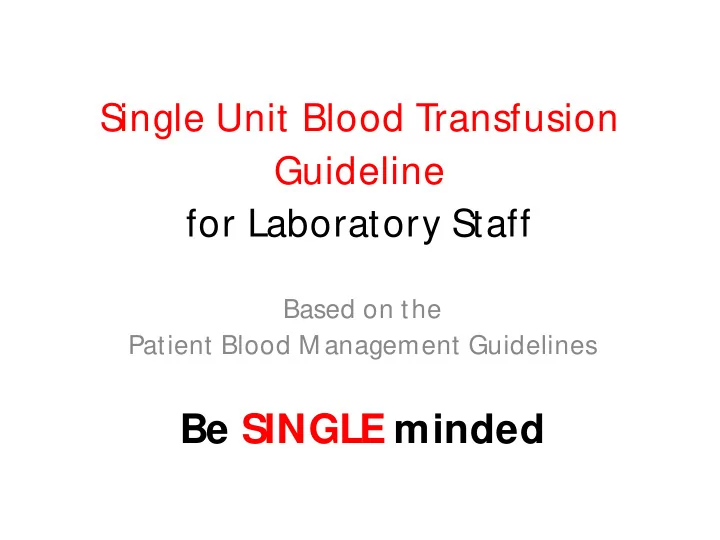

Single Unit Blood Transfusion Guideline for Laboratory Staff Based on the Patient Blood M anagement Guidelines Be SINGLE minded
Single Unit Transfusion Guideline Applies to: • The stable, normovolaemic inpatient who – is NOT actively bleeding – is NOT in an operating theatre • Haemoglobin as defined in the Patient Blood M anagement Guidelines
The Guideline Transfuse one unit, then reassess the patient for clinical symptoms before transfusing another – If the patient’s symptoms are relieved, don’t transfuse more units – Every unit is a new clinical decision – Base decision on patient symptoms, not only on haemoglobin
Single Unit Transfusion Guideline WHY Current practice does not align with evidence-based recommendations • Prescribing a single unit of blood may reduce the risk of an adverse event: – Harm from transfusion is dose dependent – Transfusion is an independent risk factor for increased morbidity, mortality and length of stay. • There is a lack of evidence for benefit of transfusion in a non-bleeding patient. Five Drivers Shifting the paradigm from Product-focused Transfusion Practice to Patient Blood M anagement” Axel Hofmann, Shannon Farmer, Aryeh Shander. The Oncologist 2011;16(suppl 3):3-11 Strategies to preempt and reduce the use of blood products: an Australian perspective. Hofmann, A et al. Curr Opin Anesthesiol 2012, 25:66-73.
Be SINGLE minded HOW When blood is ordered for a patient… ASK: – Is the patient actively bleeding? – What is the current haemoglobin? * EXPLAIN: – Only one unit will be issued, in compliance with the Patient Blood M anagement Guidelines • * If Hb <70 g/ L a 2 unit request likely to be acceptable • Note: Hb<80g/ L for patients with acute coronary syndrome Hb<100g/ L for renal patients.
Indications for a Second unit • Active blood loss • Hb < 70g/ L for general patients • Hb <80g/ L for cardiac patients* * See Patient Blood M anagement Guidelines for other patient groups • On going chest pain • Less than 8g/ L rise in haemoglobin following first unit
Single Unit Transfusion Empowered Staff: Laboratory staff can “gate-keep” compliance. • Guideline document is accessible in laboratory – prompt for questions about compliance. • Inclusion criteria for a second unit is defined. • Support from champions to resolve challenges to requests: (medical staff, haematologists)
Be SINGLE minded Refer disputes to medical staff / champions: • Politely suggest that the request is outside the guidelines • Re-confirm that the inpatient is NOT actively bleeding or NOT in the operating theatre • Provide blood if the patient is bleeding • Remain calm, polite and professional, and refer the caller to appropriate medical support staff.
Be SINGLE minded
Single Unit Transfusion Policy Benefits: Safer, evidence based transfusion PLUS: • Reduced risk for non-infectious adverse events • Reduced demand on limited blood supply • Reduced risk from new infectious agents Be SINGLE minded
Recommend
More recommend